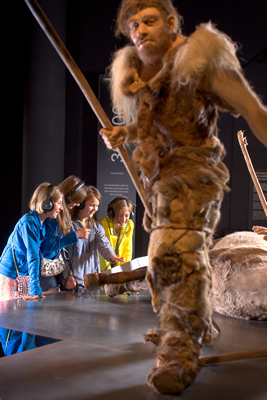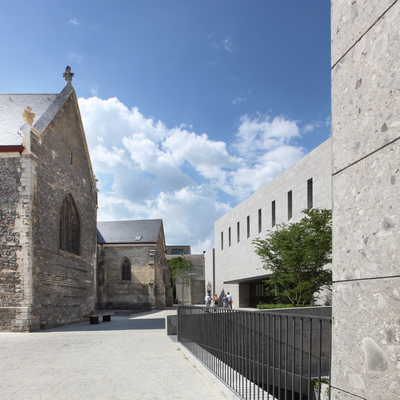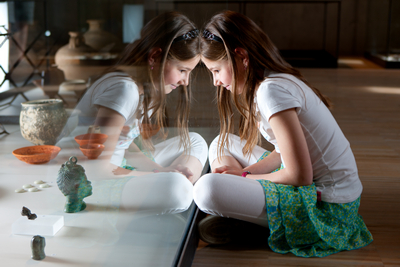Description of project
The building. The Gallo-Roman Museum is owned by the Province of Limburg (part of Flanders, Belgium) and is located in the centre of Tongeren, the country's oldest city. The museum reopened in May 2009 after three years spent renovating the existing museum building and adding a new wing. Designed by architects De Gregorio Partners, the new building is cleverly integrated into the old heart of the city, while the architectural concept and the chosen materials reinforce the city's identity. This part of the city was opened up by means of a new footpath around the Basilica of Our Lady and a museum square constructed behind the Basilica. So as well as being an important museum project, the new museum was also an inspirational urban project. This powerful, sober building with a floor area of 12,600 msup2; hopes to attract an average of 150,000 visitors a year.
The content
The project is certainly not just about bricks and mortar. On May 21st 2009 we also unveiled a completely new permanent exhibition and it is this part of the project we wish to present here.
 Overall objective of the project
Overall objective of the project
First and foremost we were keen that the permanent exhibition should provide a pleasant environment for people with varying degrees of knowledge to learn something about the past. While the core collection is Gallo-Roman, we also have a valuable collection of prehistoric artefacts. This enabled us to formulate our objective of giving visitors insight into societies in the distant past, starting from more than 500,000 years ago through to the early Middle Ages around 500 AD. A second objective was to help people understand that a society does not function as it does by chance. There are reasons why a society is what it is at a particular time, why people do what they do and are who they are.
So emphasis is given to the relationship between cause and effect; hence our motto: "What follows is always organically related to what went before" (Marcus Aurelius / 121 - 180 AD). The exhibition focuses on the history of the region we now call Limburg and on all aspects of that history: politics, culture, climate, daily life, etc. At the same time we make it clear that developments in this small geographical area are inextricably linked to evolution in a wider, largely European context. We also endeavour to give people some understanding of archaeological science and make them aware that there are limits to what we know about the distant past. Finally, we hope that by presenting the subject matter in an attractive manner people will come to recognize and appreciate the importance of our cultural heritage.
Strategy for implementation
Period: 2002 - May 2005. First came the long phase of concept development during which museum staff systematically consulted specialist literature, visited other museums, analysed the strengths and weaknesses of the previous presentation and formulated objectives. It had been established that the museum should provide a permanent exhibition where visitors could learn something, which respected the chronology and allowed the intrinsic story to take precedence. While we do see the objects in the collection as the most important medium for putting across the subject matter, they are only ever media and never the central focus. We use other media (films, texts, figures, etc.) to inform visitors about episodes we cannot illustrate with the items in the collection.
Period: May 2005 - end 2006. In developing the preliminary concept, we were assisted by Event Communications, London. This design company helped us articulate the content and narrative by dividing the continuous and chronologically written scientific story into manageable exhibition clusters. The company also helped us select the most appropriate media. However, rather than relying purely on our combined expertise when developing an exhibition concept, we also took into account the findings of our market research. We had asked our (potential) public if, what and how they wanted to learn in an archaeological museum like ours. So the design process took account of the wishes, expectations and varying degrees of knowledge of several visitor groups: ls"those looking for information through observation, ls"those looking for a socio-active experience' and ls"those looking for an auto-active experience'.
Period: February 2007 - March 2008. Once the preliminary concept had been developed, work on the final concept and design process could begin. We appointed set designer Niek Kortekaas and Alfredo De Gregorio's firm of architects. It then took more than a year to develop a final concept, integrate concept and content into a clearly legible design and to draw up the plans.
Period: summer 2008 - May 2009. The plans were executed in a very short space of time. We worked with a number of specialized agencies (graphic artists, model-builders, draughtsmen, audiovisual studio, etc.), all true experts in their field.
 Method deployed
Method deployed
We bring the distant past to life with 2,200 authentic exhibits, including many ls"perfectly ordinary' utility objects. The items are presented in large, open, convivial spaces. Despite the numerous objects on show, the display cases are never crowded. The occasional free-standing display, without glass, is used to show larger architectural fragments, tombstones and idols to their best advantage.
Layer1. There is a clear ls"path' through the galleries. The most important facts are formulated succinctly along the way. The ls"path' is interrupted four times by a gigantic synthetic object. As well as being eye-catching, these objects also serve as ls"stop signs', prompting visitors to pause at four crucial transition points: 500,000 years ago - first people, first culture; 5300 BC - the new agricultural society; 825 BC - the development of a stratified society with Celtic features; 10 BC - the romanizing of the region.
Layer2. The exhibition deploys a variety of media. For example, the clear, jargon-free texts are constructed newspaper-style with headline, lead and body. Several touch tables have also been integrated into the presentation. Atmospheric drawings are used to clarify specific points. The many educational films, demonstrating for example a specific technology, were specially made for this exhibition and have proved a great draw. The moving prints and interactives for children, immediately recognizable by their format, have proved very successful. The displays also feature unambiguous, life-size synthetic figures. As a result, sometimes complex material becomes accessible not only to the classic museum visitor, but also to people sensitive to atmosphere looking to empathize with the distant past, and to children looking for ls"an experience'. Moreover, we regularly use what we call the ls"train of thought' approach. We ask a question about which there is scientific uncertainty and then present several accepted hypotheses.
Layer3. Maps play a key role in these zones. They show visitors which cultural area Limburg belonged to in a specific period (graphics). Animated maps (video) are used to present external influences such as the arrival of the first people, the emergence of the first farmers or the growth of the Roman Empire.
In other words, in terms of the media used, the exhibition concept is structured, layered and diverse so as to meet the needs of various target groups.
 Outcome
Outcome
Now. Between May 20th 2009 and May 2012 more than 300,000 people visited the permanent exhibition. Judging by the spontaneous reactions recorded in a book on leaving the museum, the feedback has been largely positive. Interestingly, it is not only those with little prior knowledge of the subject and schoolchildren who find the exhibition fascinating and attractive but also amateur archaeologists and scientists. Various newspaper articles have commended the museum both for its new architecture and its clear, educational presentation.
Near future
The museum is to carry out quantitative research to obtain scientifically-based evaluations with a view to making adjustments to the permanent exhibition. Still in the pipeline is the improvement/finalization of information for French, German and English-speaking visitors (10% of our public). The temporary versions of the visitor guide and films currently in use will be replaced by a finalized version in various languages. There are also plans to fine-tune the signage in the building.
Future
Every year we organize a temporary exhibition that ties in with the permanent collection for which quality items are loaned from museums abroad. From November 2011 till Juin 2012 we presented the first retrospective exhibition about the extraordinary archaeological site Sagalassos in Turkey (www.sagalassos.be) in association with the Catholic University of Leuven (KUL). This exhibition attracted more than 130.000 visitors. We will also continue to work systematically on various programmes for schoolchildren, particularly the 10-14 age group: interactive guided tours, workshops and educational walks. They also link up with the permanent exhibition. For example, several years ago we started developing a game on a palm hand-held computer (PDA) for children aged between 12 and 14, which is also attractive to pupils studying technical subjects. With this device they can explore the permanent exhibition independently in small groups. And we plan to implement a serious game for adults groups in 2013. We also have an on-going programme of lectures and several times a year we organize worthwhile events, sometimes outside the walls of the museum. These services to the public are of course always scientifically based.
Creativity and originality
First and foremost, the new permanent exhibition can claim to be reliable and educational. In an age when everything seems to revolve around ls"fun', going all out for a sound and properly considered didactic approach requires a degree of courage. The design is contemporary and full of surprises. One of the characteristics is unity in diversity. To prevent museum weariness setting in, each of the galleries has a character and face of its own while being part of the same family. The choice of coarse materials echoes the architecture of the building. Much originality also went into the stratified presentation and into the diversity of media whilst carefully avoiding the ls"theme park effect'.
Cost-effectiveness and budgets
Fees. The total cost of designing the exhibition was 518,243.00 EUR, incl. 21% VAT. This covered the fees of the various design and development bureaus.
Execution: The budget for creating the exhibition was 3,002,750.00 EUR incl. VAT (6% / 21%, depending on the item), a relatively modest sum given the 2,600 msup2; of exhibition floor space. The budget (excl. VAT) was allocated as follows: carpentry, glass, metal work, electricity: euro;1,074,196.38; Building-related items such as parquet floor and paintings: euro;498,523.94; Media design and production of audiovisuals and interactives: euro;350,000.00; Hardware: euro;225,046.89; Drawings: euro;23,230.00; Printing: euro;59,755.41; Synthetic figures and zoological replicas: euro;169,480.00; Replicas of weapons: euro;13,075.00; Models: euro;122,500.00; Sculptures: euro;26,000.00.